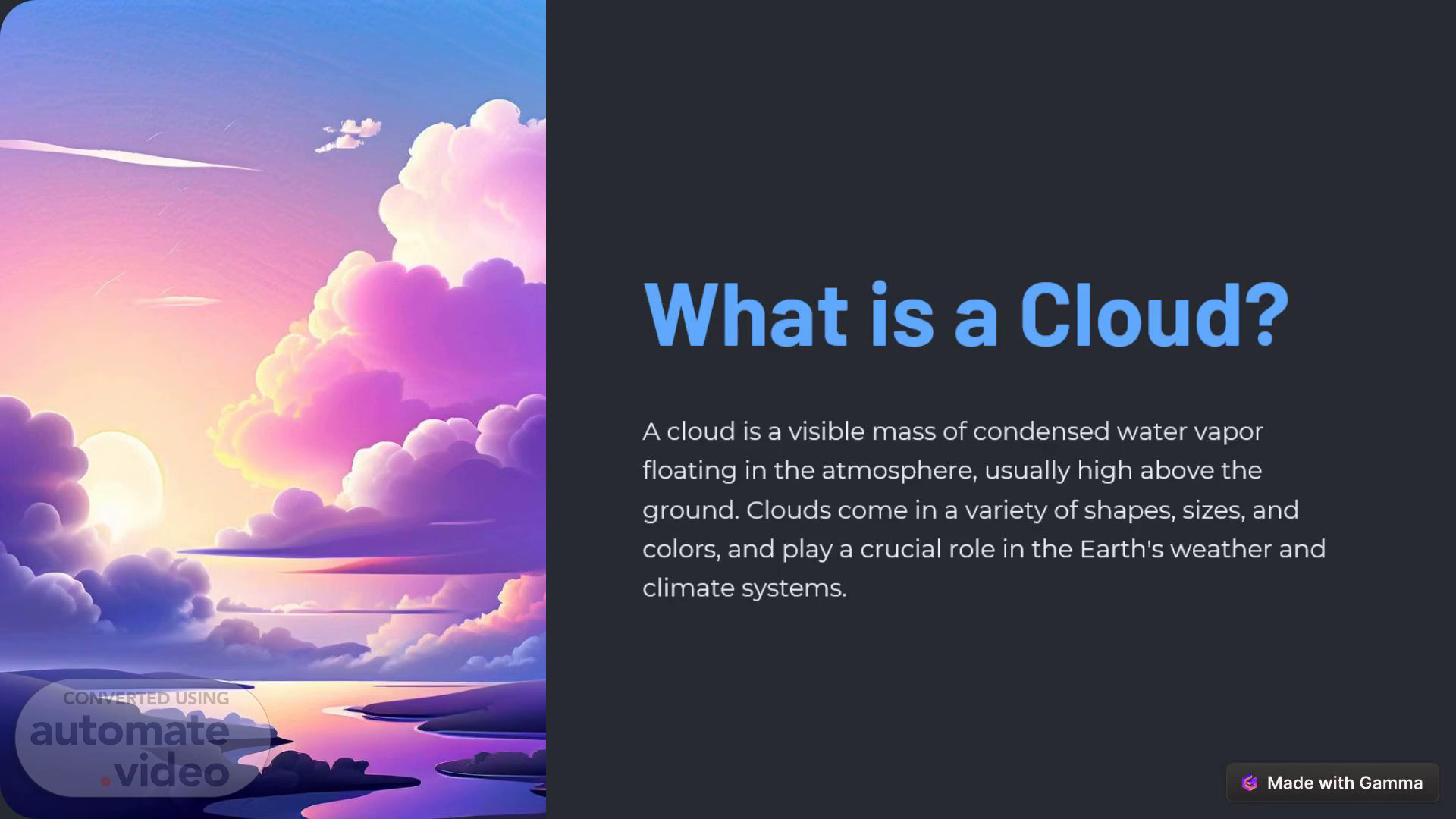
PptxGenJS Presentation
Scene 1 (0s)
[Audio] What is a Cloud? A cloud is a visible mass of condensed water vapor floating in the atmosphere, usually high above the ground. Clouds come in a variety of shapes, sizes, and colors, and play a crucial role in the Earth's weather and climate systems..
Scene 2 (16s)
[Audio] Formation of Clouds Evaporation Water from the Earth's surface evaporates into the atmosphere, forming water vapor. Cooling As the water vapor rises, it cools and condenses into tiny water droplets or ice crystals, forming clouds. Saturation The air becomes saturated with water vapor, and the condensation process continues, leading to the growth of the cloud..
Scene 3 (42s)
[Audio] Types of Clouds Low-Level Clouds Mid-Level Clouds High-Level Clouds Cumulus, Stratus, and Nimbostratus clouds, which form close to the Earth's surface. Altostratus and Altocumulus clouds, which form at higher altitudes. Cirrus, Cirrostratus, and Cirrocumulus clouds, which form at the highest altitudes..
Scene 4 (1m 6s)
[Audio] Cloud Properties Composition Size Clouds are primarily composed of water droplets or ice crystals, with varying amounts of other particles such as dust, pollution, and salt. Clouds can range from small, puffy formations to massive, sprawling systems that cover large areas of the sky. Altitude Movement Clouds can form at different heights in the atmosphere, from near the ground to the upper troposphere. Clouds are carried by wind currents and can move at various speeds, affecting weather patterns and precipitation..
Scene 5 (1m 39s)
[Audio] Cloud Classification Clouds come in a variety of shapes and forms, each with their own unique characteristics: Cumulus Stratus Fluffy, white, and puffy clouds that often resemble cotton balls. Flat, gray clouds that often cover the entire sky in a uniform layer. Cirrus Cumulonimbus High-altitude, wispy, feather-like clouds made of ice crystals. Towering, anvil-shaped clouds that often produce thunderstorms..
Scene 6 (2m 8s)
[Audio] Importance of Clouds Water Cycle Climate Regulation Clouds play a crucial role in the water cycle, facilitating the movement of water between the Earth's surface and the atmosphere. Clouds help regulate the Earth's temperature by reflecting and absorbing solar radiation, influencing the planet's climate and weather patterns. Precipitation Ecosystem Support Clouds are the source of precipitation, such as rain, snow, and hail, which are essential for sustaining life on Earth. Clouds provide shade and moisture, creating habitats and supporting the growth of various plant and animal species..
Scene 7 (2m 47s)
[Audio] Clouds and Weather Cloud Formation Clouds form due to the condensation of water vapor in the atmosphere. Cloud Type Different cloud types are associated with different weather conditions. Weather Prediction Observing and understanding cloud patterns helps meteorologists predict weather conditions..
Scene 8 (3m 8s)
[Audio] Thank you • Thank you all for attending today's presentation. I hope you found the information valuable and engaging. • As we wrap up, I want to leave you with a few key takeaways to remember. • First and foremost, remember that [summarize key message or call to action from previous slides]. • Additionally, I encourage you all to [provide relevant next steps or action items]. • Please feel free to reach out if you have any other questions. I'm happy to discuss this further. • Thank you again for your time and attention. Have a great rest of your day!.